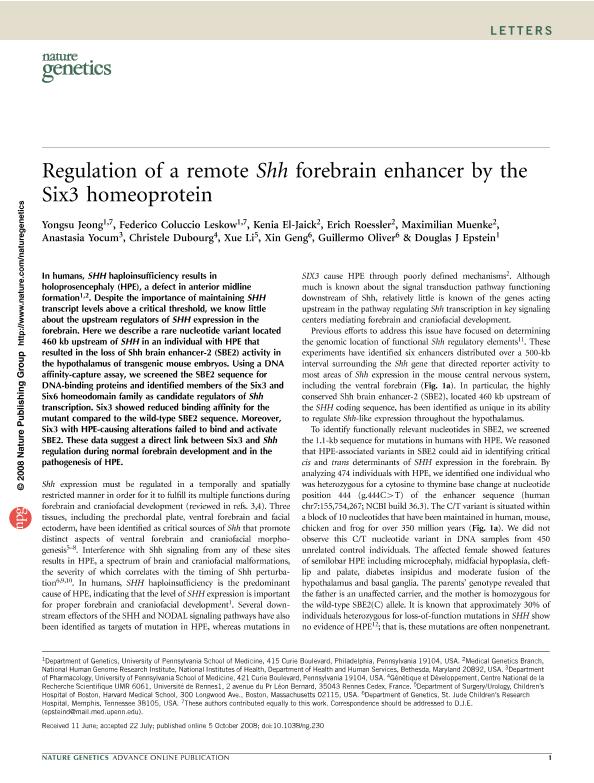Mostrar el registro sencillo del ítem
dc.contributor.author
Jeong, Yongsu
dc.contributor.author
Coluccio Leskow, Federico

dc.contributor.author
El Jaick, Kenia
dc.contributor.author
Roessler, Erich
dc.contributor.author
Muenke, Maximilian
dc.contributor.author
Yocum, Anastasia
dc.contributor.author
Dubourg, Christele
dc.contributor.author
Li, Xue
dc.contributor.author
Geng, Xin
dc.contributor.author
Oliver, Guillermo
dc.contributor.author
Epstein, Douglas J.
dc.date.available
2019-09-18T19:21:59Z
dc.date.issued
2008-11
dc.identifier.citation
Jeong, Yongsu; Coluccio Leskow, Federico; El Jaick, Kenia; Roessler, Erich; Muenke, Maximilian; et al.; Regulation of a remote Shh forebrain enhancer by the Six3 homeoprotein; Nature Publishing Group; Nature Genetics; 40; 11; 11-2008; 1348-1353
dc.identifier.issn
1061-4036
dc.identifier.uri
http://hdl.handle.net/11336/83860
dc.description.abstract
In humans, SHH haploinsufficiency results in holoprosencephaly (HPE), a defect in anterior midline formation. Despite the importance of maintaining SHH transcript levels above a critical threshold, we know little about the upstream regulators of SHH expression in the forebrain. Here we describe a rare nucleotide variant located 460 kb upstream of SHH in an individual with HPE that resulted in the loss of Shh brain enhancer-2 (SBE2) activity in the hypothalamus of transgenic mouse embryos. Using a DNA affinity-capture assay, we screened the SBE2 sequence for DNA-binding proteins and identified members of the Six3 and Six6 homeodomain family as candidate regulators of Shh transcription. Six3 showed reduced binding affinity for the mutant compared to the wild-type SBE2 sequence. Moreover, Six3 with HPE-causing alterations failed to bind and activate SBE2. These data suggest a direct link between Six3 and Shh regulation during normal forebrain development and in the pathogenesis of HPE.
dc.format
application/pdf
dc.language.iso
eng
dc.publisher
Nature Publishing Group

dc.rights
info:eu-repo/semantics/openAccess
dc.rights.uri
https://creativecommons.org/licenses/by-nc-sa/2.5/ar/
dc.subject
Sonic Hedgehog
dc.subject
Mouse Development
dc.subject
Forebrain Enhancer
dc.subject
Six
dc.subject.classification
Biología Celular, Microbiología

dc.subject.classification
Ciencias Biológicas

dc.subject.classification
CIENCIAS NATURALES Y EXACTAS

dc.title
Regulation of a remote Shh forebrain enhancer by the Six3 homeoprotein
dc.type
info:eu-repo/semantics/article
dc.type
info:ar-repo/semantics/artículo
dc.type
info:eu-repo/semantics/publishedVersion
dc.date.updated
2019-02-12T17:07:38Z
dc.journal.volume
40
dc.journal.number
11
dc.journal.pagination
1348-1353
dc.journal.pais
Reino Unido

dc.journal.ciudad
Londres
dc.description.fil
Fil: Jeong, Yongsu. University of Pennsylvania; Estados Unidos
dc.description.fil
Fil: Coluccio Leskow, Federico. Consejo Nacional de Investigaciones Científicas y Técnicas; Argentina. University of Pennsylvania; Estados Unidos
dc.description.fil
Fil: El Jaick, Kenia. National Institutes of Health; Estados Unidos
dc.description.fil
Fil: Roessler, Erich. National Institutes of Health; Estados Unidos
dc.description.fil
Fil: Muenke, Maximilian. National Institutes of Health; Estados Unidos
dc.description.fil
Fil: Yocum, Anastasia. University of Pennsylvania; Estados Unidos
dc.description.fil
Fil: Dubourg, Christele. Universite de Rennes I; Francia
dc.description.fil
Fil: Li, Xue. Children’s Hospital of Boston; Estados Unidos
dc.description.fil
Fil: Geng, Xin. St. Jude Children’s Research Hospital; Estados Unidos
dc.description.fil
Fil: Oliver, Guillermo. St. Jude Children’s Research Hospital; Estados Unidos
dc.description.fil
Fil: Epstein, Douglas J.. University of Pennsylvania; Estados Unidos
dc.journal.title
Nature Genetics

dc.relation.alternativeid
info:eu-repo/semantics/altIdentifier/doi/http://dx.doi.org/10.1038/ng.230
dc.relation.alternativeid
info:eu-repo/semantics/altIdentifier/url/https://www.nature.com/articles/ng.230
Archivos asociados
